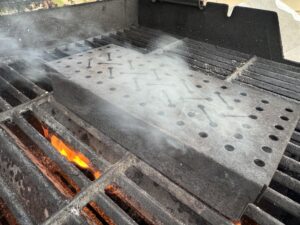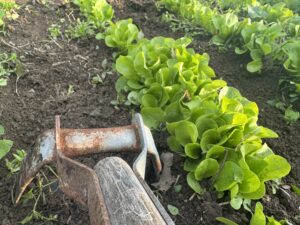 If you ask a random person on the street to name the most common tools one would use in the garden, you’re going to hear words like shovel, hoe, rake, pitchfork, and pruners. These are all useful tools that I wouldn’t want to be without, but there’s one more that no gardener should be without, and chances are you’ve never heard of it.
If you ask a random person on the street to name the most common tools one would use in the garden, you’re going to hear words like shovel, hoe, rake, pitchfork, and pruners. These are all useful tools that I wouldn’t want to be without, but there’s one more that no gardener should be without, and chances are you’ve never heard of it.
It’s called an action hoe, however I’ve always heard it referred to as a scuffle or stirrup hoe. The former is due to the motion the gardener uses and the latter is a reference to the shape of the implement’s working head. An action hoe works by agitating the crust of the soil and cutting just underneath the surface to sever and dislodge the roots of whatever is in its way. It feels effortless because you’re only moving a thin piece of metal through the soil compared to a traditional hoe that uses a large flat blade to dislodge and move material.
Action hoes are cheap, lightweight, and grossly underrated. This tool will change the way you think about weeding a garden. I love spreading the word about action hoes because it keeps gardeners from quitting the hobby out of frustration and discouragement. It also increases the likelihood that elderly or physically limited individuals will continue gardening by reducing the physical strain and discomfort typically associated with the task. Even an individual who may no longer be capable of a strenuous day of double digging their garden beds can hit every one of their beds with an action hoe and not feel it the next day.
Gardening is an excellent way of staying active and getting exercise and is particularly effective at working the core and activating smaller stabilizer muscles that traditional physical training sometimes overlooks. However, we should also be aware of tools and techniques we can use to help ensure it remains a joyful, stress-relieving hobby rather than a painful chore so that someone can remain a gardener for life. Let’s look at how this simple tool can help us spend less time doing what most gardeners enjoy the least about the hobby.
Weeds, Weeds, and More Weeds
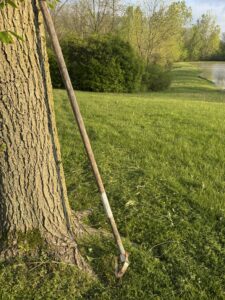 Why do so many gardeners decide it’s not worth it and throw in the towel? In a word, weeds.
Why do so many gardeners decide it’s not worth it and throw in the towel? In a word, weeds.
Weeds are nature’s freeloaders—crashing the garden party uninvited, refusing to leave, and drinking all the sunlight. They cause problems early in the season when we’re not sure what’s coming up is or isn’t a seedling, and by late summer, the garden—once full of promise—has turned into a battlefield lost. The weeds rise like an invading army, choking the life from carefully planted rows. Each tug of nutsedge or thistle feels more futile than the last, until the gardener, sunburnt and disheartened, drops the trowel in silent surrender. Hope wilts under the weight of bindweed and neglect, and a quiet resignation sets in: maybe next year—a phrase I heard a lot at my Marine Reserve unit in Cleveland when people talked about the Browns. We’ve all been there with our gardens.
Maintenance
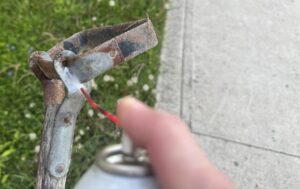 While we don’t think of it as a cutting tool per se, the leading edge of the stirrup can become dull over time, especially if it’s hitting small rocks and woody roots. Clean up the edges with a mill file when you notice that it’s requiring more force to cut through weed roots than usual. Apply a few drops of penetrating oil or white lithium grease to the hinges where the stirrup meets the bracket that secures it to the handle. You can rub some tung oil or linseed oil into the wooden handle to keep it from drying out and cracking.
While we don’t think of it as a cutting tool per se, the leading edge of the stirrup can become dull over time, especially if it’s hitting small rocks and woody roots. Clean up the edges with a mill file when you notice that it’s requiring more force to cut through weed roots than usual. Apply a few drops of penetrating oil or white lithium grease to the hinges where the stirrup meets the bracket that secures it to the handle. You can rub some tung oil or linseed oil into the wooden handle to keep it from drying out and cracking.
Where to Buy
A decent quality action hoe costs around $30 to $35. I’ve been using one manufactured by Ames for more than 15 years. You should be able to find one at any garden center or hardware store, but don’t count on the average store associate to know what you’re asking for. If they have them, they will be with the rest of the long-handle garden tools. Many manufacturers offer a lifetime warranty, so hang onto your receipt and you’ll never have to pay for another one should you need to replace it.
This is a simple implement, so there isn’t much to compare between different options. A rubber grip on the upper part of the handle is helpful but not necessary, as you’re not going to be using much force with this tool. Fiberglass handles are superior for garden tools that are meant for digging or prying, but I prefer the traditional feel and control of a wooden handle on a tool like this. This is a simple tool, and in fact, every action hoe I’ve seen for sale has had a wooden handle.
How to Use It
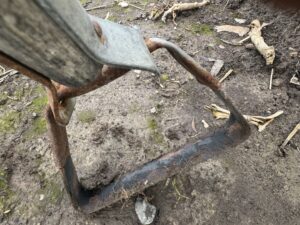 Shuffle the hoe forward and back through the soil deep enough to cut through or under the roots of the weeds. Weeds can be incredibly resilient, and it’s a best practice to pick out the uprooted weeds by hand and toss them out so they don’t have a chance to settle back into the soil and get a second lease on life.
Shuffle the hoe forward and back through the soil deep enough to cut through or under the roots of the weeds. Weeds can be incredibly resilient, and it’s a best practice to pick out the uprooted weeds by hand and toss them out so they don’t have a chance to settle back into the soil and get a second lease on life.
A huge advantage of an action hoe is its ability to get right up to the stem of a plant. I can weed a 4’ x 8’ bed in less than two minutes with this tool. It honestly feels like cheating as long as I continue to add compost to my beds to keep the soil friable and maintain a regular watering schedule.
An action hoe shines in beds where you have lots of open space in between single stems, such as peppers and tomatoes. With a little bit of practice, you won’t even have to pull the weeds closest to the stem because you’ll be able to get them with this tool. Just be careful how much force you use when you’re near a plant you want to keep since the cutting edge can sever even the woodier stalks of plants like peppers and okra in one over-spirited flick of the wrist.
You can even flip the hoe on edge and easily get into 90-degree corners of raised beds where weeds love to take root. It does well with thistle if it’s young enough and if your soil is loose enough to get the cutting edge completely under the root so that you can toss the whole plant out of your garden (and not into your compost bin!). As any seasoned garden can attest, thistle infamously returns a few days later if you leave even part of the root in the ground.
Other Benefits
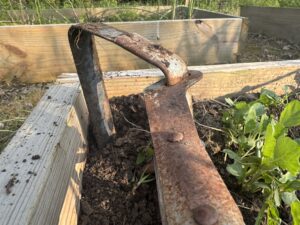 The action hoe lets us eliminate our weeds but doesn’t majorly affect soil structure because we’re only disrupting the top inch or two of soil. Not only do we keep beneficial bacterial and fungal colonies healthy and intact, but we avoid bringing dormant weed seeds to the surface to germinate.
The action hoe lets us eliminate our weeds but doesn’t majorly affect soil structure because we’re only disrupting the top inch or two of soil. Not only do we keep beneficial bacterial and fungal colonies healthy and intact, but we avoid bringing dormant weed seeds to the surface to germinate.
The better the tilth of your soil, the better this tool is going to work. The action hoe goes through soil rich in organic matter like a hot knife through butter. Don’t let your soil completely dry out, especially if it’s heavy clay. The hoe won’t get deep enough to cut the root of the weeds in rock hard soil that has been allowed to dry out and bake in the sun. You can still work the hoe across the surface of hardened or unworked soil to “scratch” out the weeds but just be aware you’re mostly removing only the very tops of the weeds and leaving the parts that will regrow untouched.
I hope I’ve given you some reassurance in your ability to stay on top of weeds this growing season. Let me know in the comments or send me a message and tell me if this tool has made things easier for you.
As always, do the work, help another gardener in need whenever you can, enjoy the fruits of your labor, and have fun along the way. Thanks for being part of the Richwood Gardens community.
If you enjoyed this article or found it helpful, I’d truly appreciate it if you shared it with a friend. Also, if you’re interested in learning about some of the items I have found most useful in my own gardening and cooking, you can check them out on my Product Reviews page. As an Amazon Associate, I earn from qualifying purchases, which helps me keep growing so I can bring you even more valuable content.

